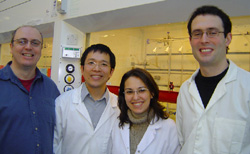Exercising Demons: A Molecular Information Ratchet
‘Exercising Demons: A Molecular Information Ratchet’, Viviana Serreli, Chin-Fa Lee, Euan R. Kay and David A. Leigh, Nature, 445, 523-527 (2007). Full Article. Making the Paper. Nature Nanotech N&V's. How it Works.
‘Exercising demons’. Click on image to download high resolution version (jpeg).
[This illustration by Regina Fernandes – Illugraphics.]
Chemists in the Leigh group have created a molecular machine that operates via a mechanism inspired by a 140 year-old thought experiment. The ‘molecular information ratchet’ uses light energy to fuel information transfer, a fundamentally new type of motor-mechanism for artificial nanomachines.
Nature uses molecular-sized motors and machines in virtually every important biological process and their extraordinary success is inspiring scientists to try to create synthetic devices that mimic the function of these amazing natural systems. However, it is far from obvious to see how to design such machines because mechanical behaviour at the molecular level, where everything is constantly moving (under kinetic energy supplied by the heat of the surroundings) and being buffeted by other atoms and molecules (Brownian motion), is very different to that which we observe in our everyday world. One cannot just scale down the design of a motor car to the nanoscale, for example, it simply could not operate because friction, heat dissipation and many other factors are so different. The problem of controlling motion on the molecular level is not a recent one, however, it has occupied the minds of scientists since as far back as the middle of the 19th Century.
James Clerk Maxwell
James Clerk Maxwell (1831–1879),[1] born and raised in Edinburgh, was arguably one of the three (along with Isaac Newton and Albert Einstein) most important and influential scientists of all time ["From a long view of the history of mankind - seen from, say, ten thousand years from now - there can be little doubt that the most significant event of the 19th century will be judged as Maxwell's discovery of the laws of electrodynamics." — Richard Feynman; "The work of James Clerk Maxwell changed the world forever" — Albert Einstein; "Maxwell's equations have had a greater impact on human history than any ten presidents." — Carl Sagan]. During a lifetime of contributions to science that began at age 14, two pieces of Maxwell’s work are generally the most celebrated: His electromagnetic theory of light; and his contributions to the kinetic theory of gases, which for the first time explained real-world properties in terms of the statistical behaviour of atoms and molecules. These two theories have become cornerstones of modern physical science but ‘Maxwell’s Demon’,[2] an offshoot of his work on the kinetic theory of gases, has had its own extraordinary impact.[3] Time and again it has captured the imagination and interest of scientists in different fields, profoundly influencing the development of statistical and quantum physics, information theory, computer science and cybernetics. Now, 140 years after its conception, it is the inspiration for a new motor mechanism for nanomachine systems reported by Serreli et al in Nature.[4]
‘The molecular information ratchet team in the James Clerk Maxwell Building, University of Edinburgh, 8th December 2006’ Left-to-right: Dr Euan Kay, Dr Chin-Fa Lee, Dott. Viviana Serreli and Prof Dave Leigh. [Click photo to enlarge]
Maxwell’s Demon
In 1867,[2] Maxwell proposed the thought experiment which has come to be known as ‘Maxwell’s Demon’ (Figure 1). In the original version of this imaginary system, a tiny intelligent being – a ‘demon’ – is able to open and close a gate connecting two boxes filled with gas so as to allow only fast (‘hot’) gas molecules to flow into one box and only slow (‘cold’) gas molecules into the other – creating a temperature difference between the two compartments (Figure 1a). If the demon can perform such a task without expending any energy (using a frictionless gate which he opens and closes very slowly), then such a result would be in violation of the Second Law of Thermodynamics (‘heat cannot spontaneously pass from a colder to a hotter body’ or, more generally, ‘the entropy of an isolated system not at equilibrium will tend to increase over time, approaching a maximum value’) which is one of the most fundamental principles of physics. Maxwell appreciated that other types of ‘sorting demon’ could be imagined that would also violate the Second Law, for example a system that allowed particles to pass between compartments in one direction but not the other without an energy input (Figure 1b).

Figure 1. The Maxwell Demon thought experiments. a Maxwell’s ‘temperature demon’[2a,b] in which a gas at uniform temperature is sorted into ‘hot’ (red) and ‘cold’ (blue) molecules. The demon opens the gate between the compartments when it detects a cold particle approaching the gate from the left or a hot particle coming from the right, thus separating the particles according to their thermal energy and creating a temperature differential between the compartments. b A Maxwellian ‘pressure demon’[2c] in which a concentration gradient is established by the gate being opened only when a particle approaches it from the left. In both versions of the thought experiment the idea is that the demon’s actions involve no work being done, but as the end-result is a reduction in the entropy of the gas this is in conflict with the Second Law of Thermodynamics. Maxwell appreciated that the successful operation of the demon in the thought experiment somehow relied on its intelligence as an animate being. Subsequent analysis by several generations of scientists revealed a fundamental link between entropy and information, significantly influencing the development of statistical and quantum physics and chemistry, information theory and computer science.
‘The molecular information ratchet team’ Left-to-right: Prof Dave Leigh, Dr Chin-Fa Lee, Dott. Viviana Serreli and Dr Euan Kay. [Click photo to enlarge]
Exorcising Demons
In formulating his thought experiment, Maxwell was only interested in illustrating the statistical nature of the Second Law, but subsequent generations of inventors and philosophers have been fascinated by its implications for the creation of a perpetual motion machine. A temperature or pressure differential between two compartments can be used to do work, so if one could be established without expending any energy it could form the basis for a ‘something-for-nothing’ device which does work without requiring fuel! Such a machine is impossible, of course, and is NOT what Serreli et al were trying to achieve through the work described in Nature. But why is it not possible for a demon do the necessary sorting task without an input of energy? The solution to this paradox took more than a century to fully resolve[5] but it was eventually understood through the discovery that no matter how you design your ‘demon’ component, any device that is able to process and act upon information has an inherent energy requirement that always saves the Second Law. This is due to the fundamental relationship between information and entropy – the link that, for example, requires memory erasure in computers to feed entropy into the environment (Landauer’s principle[6]).



